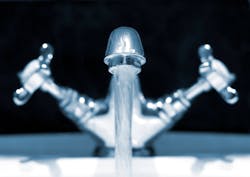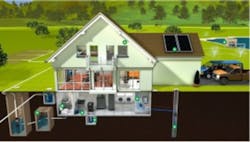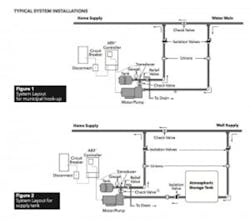Whether homeowners are washing the laundry, bathing their kids, running the dishwasher, cleaning the car or doing all these things at once, they expect a constant, continual flow of water. For many, this is not always the reality.
Installing a constant pressure system can alleviate the nuisance of water pressure inconsistency. A constant water pressure system provides residents with what they want — continuous, high-pressure water for all household needs — no matter what amount of water might be coming down the pipeline.
A constant pressure system operates with a variable frequency drive (VFD) pump controller that automatically monitors household water demand. Like the cruise control on a car, the VFD speeds up or slows down the pump depending on the water demands. The result is reliable, constant pressure where and when residents need it.
Homeowners want dependable and consistent water pressure. A constant pressure system can take dismal rural or suburban water pressure to better-than municipal water pressure. Most constant pressure systems can be installed on an existing conventional 4-inch well pump system regardless of the pump and/or motor manufacturer.
A diagram of a home water system. Images courtesy of Xylem Inc.
External factors can also influence water pressure. These include a private water well system or a utility pipeline that does not have a steady enough water supply to maintain constant pressure during multiple water-dependent, household chores. Homes with conventional private wells, common in rural locations, often experience inadequate or low water pressure because of dwindling well levels, increased water use or a newly installed irrigation system.
A constant pressure system draws water from either a well or municipal system to enhance the pressure. Most water well systems for residential use are designed to operate at a pressure of 40 to 60 psi. As the water in the tank is depleted, the pressure falls, and that is when homeowners experience fluctuations or low water pressure. A constant water pressure system boosts water to the desired psi and maintains that pressure regardless of usage trends.
Constant pressure benefits
With a constant pressure pumping system, the water pressure within the house will remain steady regardless of how many family members are consuming water. The pump automatically increases its speed as faucets, appliances and irrigation systems are turned on to maintain the chosen pressure at any flow rate.
A constant pressure system features several benefits for installers and homeowners, including:
- Reduction or elimination of noisy pipes because of a soft start/stop feature
- Total system protection, helping avoid costly repairs by automatically shutting off the pump if it detects no water, loss of prime or an over-current and voltage situation
- A more compact layout using the existing pressure tank or a smaller tank
- Easy system expansion for future household needs
- Energy and operational cost-savings
- More efficient operation of appliances, extending their lifetimes
- Compatibility with municipal water supply
Homes served by municipal water systems receive their water supplies from water lines that run through the city and connect to a water tower. Since so many residents rely on the same water supply, water pressure may vary from home to home, particularly during times of peak demand.
In municipalities that have aging water infrastructures, water pressure fluctuations can result. Homes located on hills or near the end of city water supply lines are more susceptible to lower water pressure.
A constant pressure system with a VFD pump controller is an economical solution for these challenges. The pump is connected to the plumbing inside the house, past the water meter. The controller is wired, monitors system conditions and supplies a constant water pressure.
As water use increases, the pump controller changes the pump speed to keep the water pressure constant. It also eliminates the need for large supply tanks, reducing the overall system footprint, and can use up to 50 percent less energy than a full-speed pump system. The constant pressure system will only operate when a need to boost the water to the desired pressure arises.
System layout for municipal connection (top). System layout for a supply tank connection (bottom).
The need for professional installers
"To get strong and consistent water pressure, the system needs to be sized correctly for the home’s water demands," says Alan Dretel, president, D&S Pump and Supply Co. "The installer will first determine the demand and then size the pump and drive accordingly. He or she can then properly install the system so it provides good water pressure for many years."
Certified installers are needed because the constant pressure systems typically use a VFD that works in conjunction with the well system. VFDs are complex electrical units that require an electrician or certified dealer to install and troubleshoot issues, if any arise. Finally, most contractors, dealers and installers will not honor the product warranty if a homeowner installed the system, so dealers and installers are critical for proper installations and warrantied equipment.
Professional contractors are typically licensed, certified and educated on installation and the latest technologies. They also may belong to professional associations that focus on providing them with the education and tools they need to stay current on the latest technologies, products and industry trends. Dealers and water treatment professionals who become certified to install this equipment provide a valuable service to their clients. Some product manufacturers also offer ongoing training.
Chris Preston is a residential water product manager with expertise in submersible and jet pumps and residential pumping systems. For more than 10 years, he has worked for Xylem Inc. and its Goulds Water Technology brand as a product design engineer and project manager on multiple global new product development projects. Preston holds a Bachelor of Science degree in mechanical engineering from Clarkson University.



